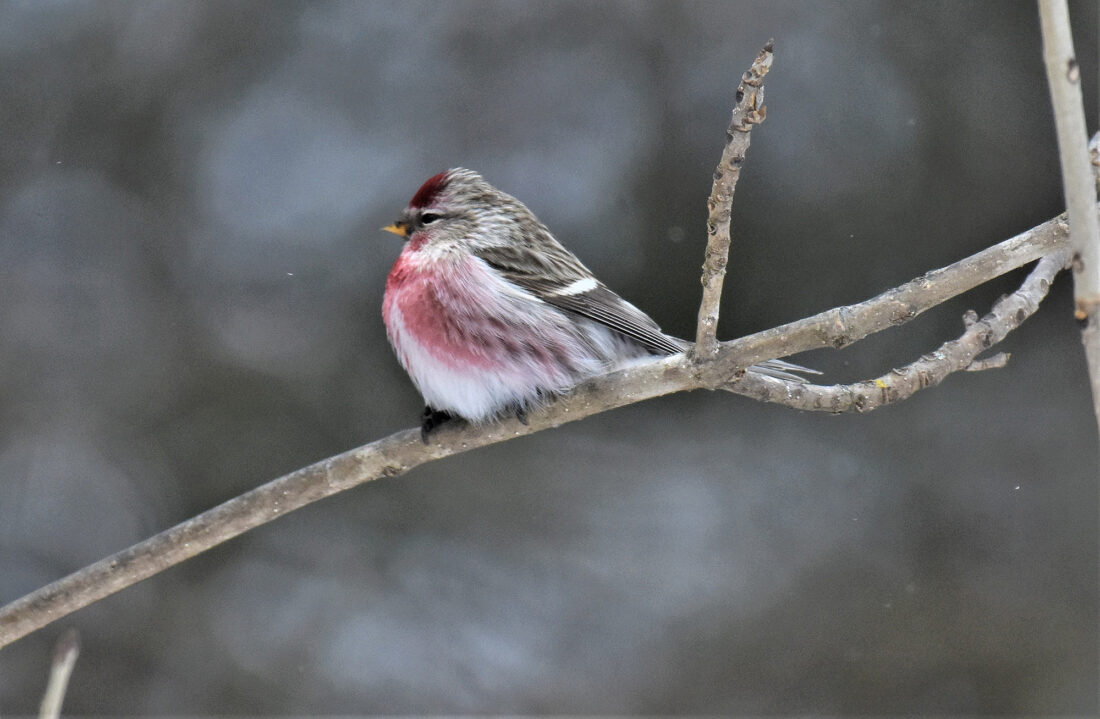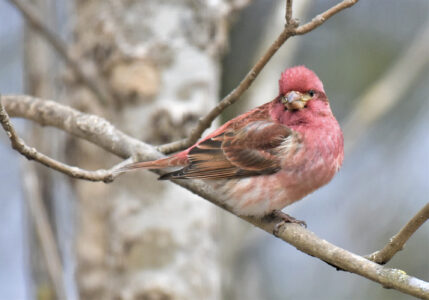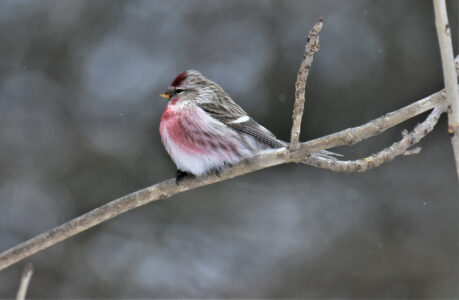Winter bird forecast somewhat brighter than a year ago
Northwoods notebook

Reports of early movement of purple finches have been occurring for weeks. (Betsy Bloom/Daily News photos)
- Reports of early movement of purple finches have been occurring for weeks. (Betsy Bloom/Daily News photos)
- Redpolls could have a strong flight south out of the boreal forest east of Lake Superior into the lower Great Lakes.
Last year I wrote in late December “no purple finches, no evening or pine grosbeaks, no pine siskins, no Bohemian waxwings, no redpolls, no red or white-winged crossbills, although flocks of the latter have been seen in northern Wisconsin.”
It did not improve with the new year. The only evening grosbeak I saw at Six Mile Lake didn’t show up until March. About the only winter finches that had a significant presence were pine siskins, and even then only late in the season into early spring.
This was not unexpected, though, given what the Winter Finch Forecast had predicted.
The Ontario, Canada-based Finch Research Network annually in fall releases its report on potential bird movement based on what food conditions are like in the north or east. For fall 2024, strong local supplies of berries, cones and other “mast” foods led forecast author Tyler Hoar to predict most flocks would remain north. That, unfortunately for us, proved accurate.

Redpolls could have a strong flight south out of the boreal forest east of Lake Superior into the lower Great Lakes.
Thankfully, this year sounds much more promising.
The 2025-26 forecast states, “With mostly very poor crops in the boreal forest from central Quebec westward to Manitoba, this has the potential of being the biggest flight year since 2020-2021.”
The forecast, as always, stresses it applies mainly to Ontario and adjacent Canadian provinces and U.S. states. Much of the Upper Peninsula and northern Wisconsin are farther west than the normal region covered in the report.
But it still can be a good indicator of what birds might wander through here during the course of the winter.
The annual report covers not just finches — such as purple finches, pine and evening grosbeaks, red and white-winged crossbills, redpolls and pine siskins — but also blue jays, red-breasted nuthatches and Bohemian waxwings that can be “irruptive” in the colder months.
According to this year’s forecast, white spruce, tamarack and white birch in the eastern boreal forest had an almost total absence of new crop, and black spruce and alders produced poorly as well.
That won’t necessarily drive the birds to the Upper Peninsula — the forecast notes above-average food crops in the Adirondack mountains east through New England and into Canada’s Maritime provinces, as well as westward through Canada into Alaska.
But those moving west could end up in the region, especially if it offers decent feeding opportunities. Birds won’t travel any farther than needed, so at least for a period of time these winter finches might choose to dwell in the U.P. this winter.
And local conditions appear good this year in terms of available fruit and acorns.
The forecast’s outlook for each noteworthy winter species:
— Purple finch: This might be the irruptive winter finch of the season in terms of venturing out of normal range. Most will migrate out of eastern Canada this winter, with some making it to the deep southern states. Reports of early movement have been occurring for weeks. Many young finches benefited from the ample food source provided by the widespread spruce budworm outbreaks. At feeders, they prefer black oil sunflower seeds.
— Redpolls: These sparrow-like birds with touches of red on forehead and breast could have a strong flight as well south out of the boreal forest east of Lake Superior into the lower Great Lakes. “Many of the redpolls coming out of the central-western subarctic/arctic regions should gravitate toward the Manitoba westward cone crop,” the forecast states. Watch for redpolls on birches, in weedy fields and at bird feeders offering nyjer and black oil sunflower seeds, the forecast states.
— Pine grosbeaks: These impressive large finches, the adult males colored like raspberry sherbert, should have a small to moderate flight this winter south to southern Ontario, southern Quebec and the border states. But, “the crop of mountain ash appears below average to poor from Lake Superior across the boreal forest into eastern Quebec,” according to the forecast. So they might be less of a presence here. Individuals wandering southward will look for mountain ash berries and small ornamental crabapples even in urban areas. In Iron Mountain, in winters when present they seem particularly drawn to the crabapple trees on the south side of the causeway over the Chapin Pit. At feeders, they prefer black oil sunflower seeds.
— Evening grosbeaks: This species — the males perhaps the most showy of the winter birds, with deep yellow and black — should have a moderate flight southward this fall, according to the forecast, though the eastern cone crop should hold wintering flocks in southern Quebec, the Maritime provinces, New England states and New York this winter.
At platform feeders, evening grosbeaks prefer black oil sunflower seeds.
— Pine siskin: A very poor cone crop should have these winter goldfinch lookalikes on the move, according to the forecast. A moderate to possibly strong flight of siskins is predicted, possibly as far south as the mid-Atlantic states. While absent much of last winter, pine siskins did appear at our feeders late in the season and in early spring.
Pine siskins’ main difference from goldfinches is they have a streaked breast. But this species, like goldfinches, prefers nyjer seeds in silo or sock feeders.
— Crossbills: While included here, it’s worth noting that crossbills don’t normally visit feeders, though several residents in the region have noticed them in their yards in the past. They prefer to feed on conifer cones, which their unique bill is designed to open to get at the seeds inside.
White-winged crossbills likely will be scarce due to an excellent spruce crop from northeastern Manitoba to Alaska and down the mountains of western Canada, according to the forecast.
The very nomadic red crossbills aren’t expected to have an influx from the west and should have modest numbers over the upper Great Lakes states. The forecast notes that red crossbill types — which move depending on food supplies, so can be from far west — are almost impossible to identify without recording their flight calls.
— Other species: Though not finches, several other birds make similar irruptive movements in some winters, so the forecast regularly includes them as well. Two of them, however, tend to be year-round U.P. residents so don’t seem so special when they show up at the feeders.
Perhaps the most prized of the non-finch winter visitors are the Bohemian waxwings. Larger than cedar waxwings and having a rusty rather than yellow patch on the underside of their tail, Bohemian waxwings are fruit eaters so will travel to where they can find decent amounts of berries or ornamental crabapples.
The forecast predicts the waxwings might move eastward into northern New England, but could roam farther west in the latter part of winter as they seek new places to forage.
Red-breasted nuthatches already have appeared as far south as Alabama’s Gulf Coast, according to the forecast. These tiny, woodpecker-like birds with the delightful nasal horn “toot” calls are, again, not uncommon here no matter what the season, but having more of them in winter would be welcome.
Blue jays should have an above-average flight, according to the forecast, though I can’t remember a winter in which these clever opportunists haven’t had a strong presence, especially when I break out the peanuts in the shell.
To read the Winter Finch Forecast 2025-2026 in full, go online to https://finchnetwork.org/winter-finch-forecast-2025-2026.
Betsy Bloom can be reached at 906-774-2772, ext. 85240, or bbloom@ironmountaindailynews.com.






